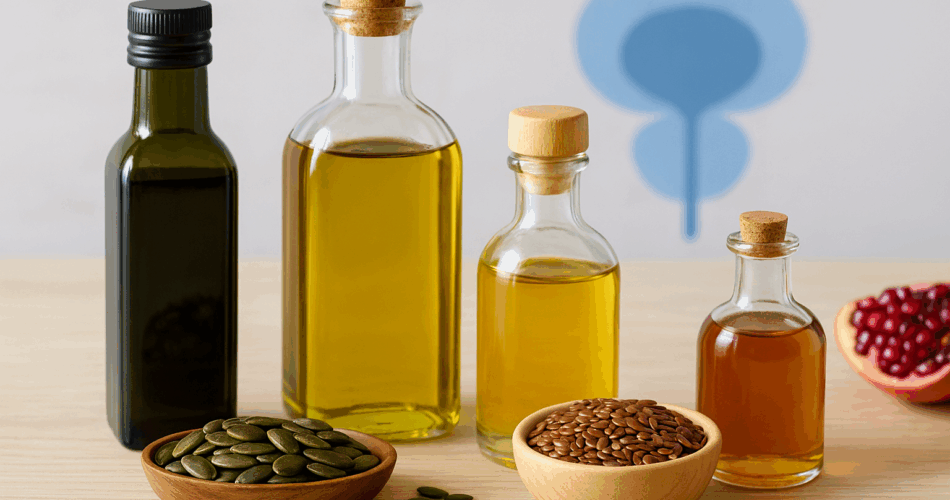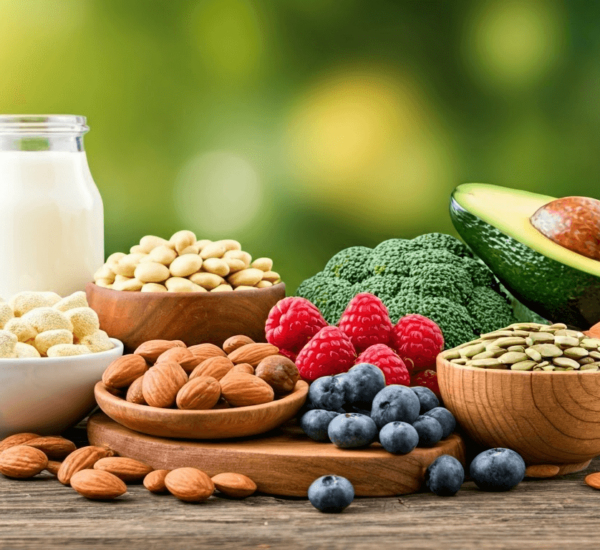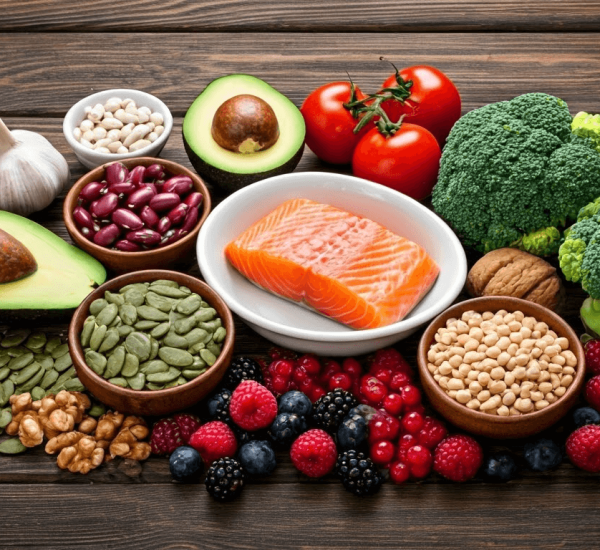Prostate comfort, urinary flow, and night-time bathroom trips often trace back to a few big drivers: inflammation, hormone signaling, and metabolic health. While no single ingredient is a magic switch, certain evidence-informed oils can become practical tools in a broader plan—food, movement, sleep, and stress management—aimed at better prostate days (and calmer nights).
Quick take: Oils rich in polyphenols, omega-3s, phytosterols, and targeted antioxidants may support a healthier inflammatory environment and more comfortable urinary function. The five below are standouts in the “Natural Remedies Dose” niche.
Why Oils Can Support Prostate Health
Inflammation, Hormones, and Urinary Symptoms—What’s the Link?
Low-grade inflammation and androgen-related pathways are frequently discussed in the context of prostate enlargement (BPH) and comfort. Diets higher in anti-inflammatory fats and antioxidants may help create a gentler internal environment, which in turn can support urinary flow and reduce nighttime frequency.
Nutrient Density, Fatty-Acid Profiles, and Antioxidants
Oils can deliver targeted compounds—from EGCG catechins to omega-3s, polyphenols, and phytosterols—that influence cellular signaling. When used consistently and appropriately, they may complement standard care and healthy routines.
How to Choose & Use Oils Safely (Fast Framework)
- Quality: Look for cold-pressed, extra-virgin, or molecularly distilled (for fish oil) and third-party testing (purity, heavy metals, oxidation).
- Form: Culinary oils (e.g., EVOO, pumpkin seed oil, coconut oil) vs. supplement oils (e.g., fish oil capsules, standardized green tea extract oil).
- Dose: Start low and consistent. Adjust gradually within standard ranges.
- Timing: Pair with meals to support absorption and reduce GI discomfort.
- Medical Fit: If on blood thinners, managing cholesterol, or preparing for surgery, seek professional guidance first.
Green Tea Extract Oil
What It Is & How It Might Help
Green tea extract oils concentrate catechins—notably EGCG—linked with anti-inflammatory and anti-androgenic activity in research contexts. For the prostate, that combination is compelling: less inflammatory noise and gentler DHT-related signaling may translate into improved comfort for some.
How to Take It
- Form: Standardized capsules or liquid drops (oil base for stability and absorption).
- Typical Daily Range: Often anchored to EGCG equivalence; many products center around 200–400 mg EGCG/day. Follow product specifics and professional guidance.
Pros
- May reduce inflammatory signaling associated with prostate discomfort.
- Convenient in capsule/drop form; easy to stack with diet.
- Often caffeine-controlled extracts vs. brewed tea.
Cons
- Not for everyone: may interact with medications or liver-metabolized drugs.
- Quality matters: choose reputable brands with catechin standardization.
- Trace caffeine in some extracts (check label).
Olive Oil (Extra-Virgin, Polyphenol-Rich)
Polyphenols & Cardiometabolic Support
Extra-virgin olive oil (EVOO) is a Mediterranean cornerstone, valued for oleic acid and polyphenols like hydroxytyrosol. Systemic inflammation and cardiometabolic strain are the “silent accelerants” of many men’s health complaints. A daily EVOO habit supports a calmer inflammatory status and better metabolic fundamentals, which may indirectly aid urinary comfort and long-term prostate wellness.
Using EVOO Daily
- Dose: 1–2 Tbsp (15–30 mL) per day.
- How: Dressings, light sautéing (low-to-medium heat), finishing oil over veggies, legumes, and fish.
- Pro tip: Seek harvest date, polyphenol score, and dark glass bottles.
Pros
- Widely studied for metabolic and inflammatory support.
- Easy to use with real food—sustainable habit.
- Pleasant flavor improves compliance.
Cons
- Heat sensitivity: keep to low-to-medium heat to preserve polyphenols.
- Calorie dense; portion control matters.
- Quality can vary widely—buy from trusted producers.
Fish Oil (EPA/DHA Omega-3s)
Omega-3s and Systemic Inflammation
EPA and DHA are well-known anti-inflammatory omega-3 fatty acids. By dialing down chronic, systemic inflammation, fish oil may help create a more favorable baseline for prostate comfort and urinary function, especially in those with low fish intake.
Purity & Dosage Notes
- Form: Triglyceride or ethyl ester; look for IFOS or similar third-party certifications, low TOTOX (oxidation) scores.
- Typical Daily Range: 1–2 g combined EPA+DHA, taken with meals.
Pros
- Robust inflammation support beyond the prostate (joints, cardio).
- Standardized dosing is straightforward with capsules.
- Works well in stacked protocols (with EVOO and pumpkin seed oil).
Cons
- Bleeding risk at higher doses or with anticoagulants—consult a clinician.
- Fishy burps if quality is poor; choose enteric-coated or refrigerate.
- Not vegetarian; algae-based omega-3s are plant alternatives.
Coconut Oil
MCTs, Energy, and Cooking Versatility
Coconut oil delivers medium-chain triglycerides (MCTs) that are quickly metabolized for energy. While not a direct “anti-androgen” or phytosterol-rich oil, coconut oil can support satiety and stable energy, helping men maintain dietary patterns (less ultra-processed food, more whole-food meals) that indirectly favor prostate comfort.
How to Use
- Dose: 1–2 Tbsp (15–30 mL) per day.
- Best For: High-heat cooking, curries, sautéing; also works in coffee/tea (start low).
Pros
- Heat stable for cooking.
- Supports meal compliance and satiety.
- Pleasant flavor in many cuisines.
Cons
- Can raise LDL in some individuals—monitor lipids.
- Calorie dense; avoid overuse.
- Not a high-polyphenol oil; use alongside EVOO or fish oil for anti-inflammatory depth.
Pumpkin Seed Oil
Phytosterols, Zinc, and Urinary Flow
Pumpkin seed oil is a classic in men’s health discussions due to its phytosterol content and natural zinc—nutrients associated with urinary symptom support in BPH contexts. Many find it particularly helpful for nocturia (night-time urination) and flow comfort when used consistently.
How to Use
- Culinary: 1–2 Tbsp (15–30 mL) daily in dressings or as a finishing oil (nutty, delicious).
- Supplement: 500–1,000 mg standardized capsules (check phytosterol content).
Pros
- Targeted urinary support stories are common.
- Great flavor encourages use in salads and bowls.
- Pairs well with EVOO in dressings for a polyphenol-plus-phytosterol combo.
Cons
- Quality variability; seek cold-pressed, dark glass.
- Caloric; measure if weight is a goal.
- Clinical effects can be individual; give it time (4–8 weeks).
A Simple 7-Day “Oil Rotation” Plan
Goal: Build consistency without boredom; layer anti-inflammatory, metabolic, and urinary-support angles across the week.
- Day 1: Breakfast veggie omelet cooked in coconut oil; lunch/dinner with EVOO dressing.
- Day 2: Fish oil with breakfast; pumpkin seed oil over a grain bowl at lunch.
- Day 3: Green tea extract oil (capsule/drops) with the main meal; EVOO over roasted veggies.
- Day 4: Coconut oil for a stir-fry; fish oil with dinner.
- Day 5: Pumpkin seed oil on salad; EVOO as finishing oil on beans.
- Day 6: Green tea extract oil + EVOO dressing; light coconut oil sauté at dinner.
- Day 7: Fish oil with brunch; pumpkin seed oil drizzle on roasted squash.
(Adjust portions to daily calorie targets and clinical guidance.)
Stacking Oils with Food, Movement & Habits
- Food: Aim for a plate that’s half colorful plants, quarter protein, quarter smart carbs; oils are the finishing strategy, not the main event.
- Movement: Daily walking (7–10k steps), mobility work, and 2–3 resistance sessions/week enhance metabolic health—critical for prostate comfort.
- Sleep & Stress: 7–8 hours and simple stress routines (breathing, sunlight) complement anti-inflammatory efforts.
- Hydration: Adequate fluids earlier in the day, tapering near bedtime to reduce nocturia.
Safety Notes, Interactions, and Who Should Avoid What
- Fish Oil: Discuss with a clinician if on anticoagulants/antiplatelets or pre-surgery.
- Green Tea Extract Oil: Potential medication interactions (liver metabolism); verify standardized products.
- Coconut Oil: Monitor lipid panels if LDL is a concern.
- All Oils: Calorie dense—keep portions aligned with weight goals.
- All Supplements: Seek professional guidance if managing chronic conditions or multiple medications.
Buying Guide & Label Checklist
- Olive Oil: “Extra-Virgin,” harvest date, origin, dark glass, higher polyphenol claim.
- Fish Oil: EPA/DHA per serving, third-party testing, low TOTOX (freshness).
- Green Tea Extract Oil: EGCG standardization, caffeine content, batch testing.
- Pumpkin Seed Oil: Cold-pressed, dark bottle, roast level (flavor), origin.
- Coconut Oil: Virgin, unrefined for flavor; refined if neutral taste preferred.
Myths vs. Facts (Rapid Fire)
- Myth: “Any oil marketed for men will shrink the prostate fast.”
Fact: Benefits depend on compounds, dose, quality, and overall lifestyle. - Myth: “Cooking with any oil at high heat is fine.”
Fact: Heat can degrade delicate polyphenols. Use EVOO low-to-medium heat; coconut oil tolerates higher heat. - Myth: “More fish oil = more benefit.”
Fact: Doses above guidance may increase bleeding risk and GI issues.
Action Checklist
- Pick 2–3 oils to start (e.g., EVOO + fish oil + pumpkin seed oil).
- Set a daily cue (e.g., drizzle on lunch salad; capsules with dinner).
- Track symptoms weekly: night-time urination, urgency, comfort.
- Reassess after 4–8 weeks; adjust dosages or swap oils as needed.
- Keep clinician in the loop, especially if on medications.
Putting It All Together—Your Next Best Step
Building a calmer inflammatory environment and better urinary comfort rarely hinges on a single hero ingredient. Instead, smart oils—used consistently, in proper forms, and alongside real-food meals, movement, and sleep—create a supportive foundation. For many, a daily EVOO base, plus fish oil for systemic support and pumpkin seed oil for urinary comfort, forms a practical core. Where appropriate, green tea extract oil adds targeted antioxidant support, while coconut oil keeps cooking simple and satisfying. Start small, track changes, and iterate with professional input.
FAQs
1) Can these oils replace medical treatment for BPH or prostatitis?
No. These oils are adjunctive dietary strategies. Anyone with persistent urinary symptoms should work with a clinician to identify causes and treatment options.
2) How long until potential benefits are noticed?
Some people report changes in 4–8 weeks of steady use, especially with pumpkin seed oil and overall anti-inflammatory patterns. Responses vary.
3) What’s the best time of day to take fish oil or green tea extract oil?
With meals. This can improve absorption and reduce GI discomfort. Split doses are fine.
4) Is coconut oil mandatory in this plan?
No. It’s mainly a culinary tool for heat stability and satiety. If lipid labs are a concern, focus on EVOO and other strategies.
5) Can someone use all five oils at once?
Possibly, in measured amounts, but it’s smarter to start with 2–3, track results, and add strategically. Always keep total calories and medical context in mind.







